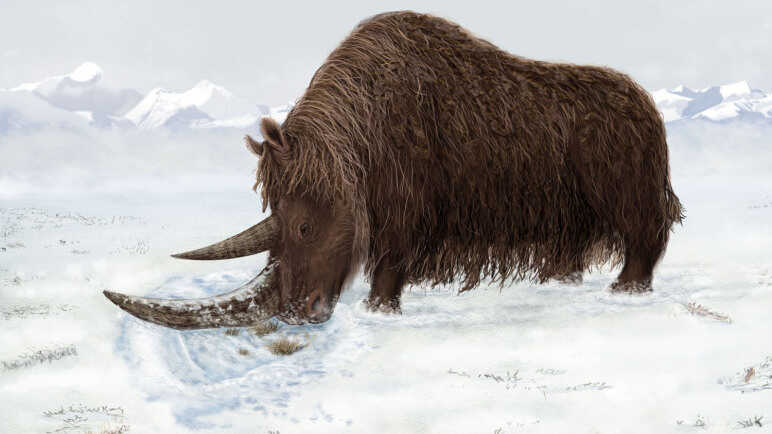How Did Animals Adapt To The Ice Age
An Ice Age Beast Evolved To Vanquish The Cold

An artist's reconstruction of the Tibetan woolly rhino. Woolly rhinos used their flattened horns to sweep snow off of vegetation, a critical adaptation to survive frigid conditions. Epitome past Julie Naylor hide caption
toggle caption
Image past Julie Naylor

An artist's reconstruction of the Tibetan woolly rhino. Woolly rhinos used their flattened horns to sweep snow off of vegetation, a critical adaptation to survive frigid conditions.
Paradigm past Julie Naylor
The Tibetan Plateau is the world'south highest place. It'southward four times the size of French republic and dwelling to most of the world's highest mountains.
As yous might expect, it'southward cold at that place. And it may be that the deep arctic of the Tibetan Plateau played a role in the evolution of some of the earth's most charismatic animals.
That's the conventionalities of a scientist who discovered the skull of a woolly rhino on the Tibetan Plateau.
The woolly rhino — two tons, 2 tusks, lots of hair and lots of attitude — was an Water ice Historic period giant. It cavorted with woolly mammoths and giant sloths and other Ice Historic period behemoths in Europe and Asia, starting about two.5 meg years agone.

Digital blended photograph of the skull and lower jaw of the woolly rhinoceros. Courtesy of Xiaoming Wang hide caption
toggle explanation
Courtesy of Xiaoming Wang

Digital blended photo of the skull and lower jaw of the woolly rhino.
Courtesy of Xiaoming Wang
Just Xiaoming Wang, from the Natural History Museum of Los Angeles County, was shocked when he found a 3.5-million-twelvemonth-old rhino skull on the Tibetan Plateau. "It caught us by consummate surprise that they are actually up in the loftier plateau well before the Water ice Age has started," Wang says.
That's about a million years before the Ice Age started, in fact. Wang thinks his discovery shows that at least some animals were prepared for the Water ice Age. "At to the lowest degree in the case of the woolly rhino, information technology really adapted itself in the cold surroundings in the Tibetan Plateau before the Ice Age has even started," Wang says.
The adaptations included hairiness, of class. And a big body, which actually does well in cold conditions. Equally you increase the volume of a body — say, what's inside the skin — the body's expanse doesn't increment equally much. Less surface area per volume ways you can retain heat improve.
Then in that location's that second, 3-foot-long horn on the woolly rhino: It was broad and apartment.
"The animal actually used it to sweep snow," Wang explains, "so they can get at the vegetation below the snow encompass."
Wang says he has other Tibetan fossils of an aboriginal bluish sheep — technically a goat — that besides eventually became a citizen of the Water ice Age.
So Wang thinks the Plateau was a sort of evolutionary cradle for cold-atmospheric condition animals. When the rest of the earth eventually iced up, they moved out of Tibet and took over.
Anthony Barnosky, a paleontologist at the University of California, Berkeley, says even at present, these isolated "cradles" are of import for evolution.
"The interesting affair," Barnosky says, "is on Earth today nosotros accept biodiversity isolated in sure spots, and we just never know which of those isolated places will be the cradle of evolution for the next big environmental change coming down the pike."
The simply problem is that to be ready, you have to know what the side by side environment will be similar. Or just exist very lucky.
The research appears in the journal Science.
Source: https://www.npr.org/2011/09/02/140121917/an-ice-age-beast-evolved-to-beat-the-cold
Posted by: mastersthearkly.blogspot.com

0 Response to "How Did Animals Adapt To The Ice Age"
Post a Comment